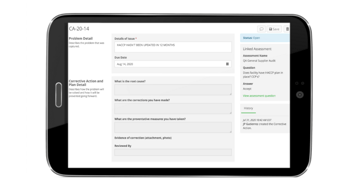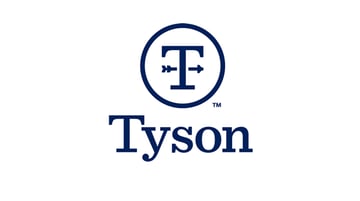Review the indispensable factors to creating a strong food quality management program that sets your quality team and overall brand up for success.
There’s no denying that food quality management is a constant and ever-evolving process. By nature, this series of practices used to ensure that products meet industry, brand and consumer standards must shift and adapt to guarantee that goods are safe and fit for consumption. This is especially true as regulations continue to expand, new products are brought to market and consumer demands, such as those surrounding transparency and sustainability, shift.
As a result, it’s important to evaluate your organization’s current food quality management strategies and quality assurance processes, analyze your program’s efficacy and efficiency, and identify both areas of success and opportunities for improvement. Below, review the essential elements to creating an expert food quality team, establishing a leading food quality management program, and ensuring that your business is constantly generating the highest quality of products.
Build Alignment across Your Food Quality Team
To construct a reliable, vigorous food quality management program, everyone in your organization must be aligned via a common understanding of goals and standards. Putting an emphasis on internal expectations, brand standards and consumer expectations is the foundation to success. Establish and communicate the requirements surrounding your brand’s food safety and quality standards, such as through onboarding, informational sessions, Standard Operating Procedure (SOP) documentation and ongoing training. Ensure that food quality plans are distributed and digitally accessible, tools utilized for quality analysis are readily available and preventive procedures are not only communicated, but understood and upheld.
Within communicating the expectations surrounding your food quality management program, it is important to recognize that your employees may have a variety of learning styles. You should anticipate this by offering a range of training techniques. This can include informational videos, in-person lessons, interactive or hands-on training, and/or written evaluation. Additionally, food quality staff should be required to participate in training procedures regardless of seniority or managerial status. During these processes, be sure to communicate and distribute required documentation, as well as document employee participation.
Foster Awareness of Common Food Safety Issues
The United States Food and Drug Administration (FDA) defines a wide variety of common food safety problems in Appendix B of the 2004 study Good Manufacturing Practices for the 21st Century for Food Processing. For example, contamination is a common food safety issue that can occur in raw materials, during processing or by reworked product. It might also originate from condensation on pipes or other equipment, potentially representing a temperature control issue. Sanitation and hygiene problems, deficient employee training and a lack of equipment knowledge are also key areas in which problems arise. And another substantial category of interest centers on a lack of programs, protocols or preventive controls, such as in relation to allergen and chemical controls, crisis management, and preventive maintenance.
It’s important for your organization and specifically, your food quality team, to demonstrate an understanding of these frequently occurring issues for preventive, as well as responsive measures. This team should establish and reference a food quality plan that clearly defines quality standards, identifies critical quality points (CQPs), details intended use, includes flow diagrams, and elaborates on common issues that arise during the manufacturing, processing and/or packing process. In addition, this plan should detail preventive processes and actions, as well as Corrective Actions (CAPAs) to be made in response to quality issues. As is crucial for training and informational processes, digital record-keeping is of utmost importance in identifying and remedying food safety and/or quality issues.
Look at the Data
Collecting and analyzing data is essential to proactively preventing quality issues, upholding a strong food quality management program, and identifying areas for improvement. The opportunities for capturing influential bites of information are vast – for example, conducting quality hazard analyses, establishing and reviewing critical limits, analyzing variances in quality attributes, and evaluating process control metrics. In addition, carrying out finished product inspections, evaluating the execution of mitigation strategies, and measuring issue response times and completion rates are also significant data points that can positively impact your food quality program.
While it’s important to regularly monitor individual accounts of this information, you should also pay attention to long-term trends. Accessing a bird’s eye view of key data trends allows you to identify patterns, hone in on issues and enact necessary changes. Fixing recurring problems will set you up for a consistently higher level of food quality, and long-term data monitoring will enable your brand to maintain recognition and consumer loyalty.
Leverage Technology
Food quality management necessitates many difficult and complex processes that involve numerous points for data capture and standards enforcement. Whereas the food industry has traditionally relied on paper-based systems or electronic solutions like Excel, leveraging software makes the whole process much more efficient, simpler and scalable. In addition to introducing automation, software solutions can provide a centralized space for digital records and documentation, preventive processes like auditing, and data analysis and reporting.
The FoodLogiQ Connect platform allows the world’s leading food brands to efficiently manage their supply chains, capture all the data needed for transparent and FSMA-compliant supply chains, and stitch together Critical Tracking Events (CTEs) to achieve real farm-to-fork traceability to quickly identify and address food safety issues. FoodLogiQ Connect enables food quality teams to log and track quality issues anywhere in the supply chain, centralize internal and external communication, and recoup the costs of nonconforming product. Report on quality issues in real-time, analyze varying data points and identify trends based on factors such as location or facility, product or ingredient, and supplier or distributor.
Combining the Elements
To create a strong, reliable food quality management program that sets your quality team and overall brand up for success, it’s important to implement the indispensable elements. Firstly, utilize open communication, accessible training, and explicit, concrete processes to build alignment and consistency across your team. Identify and prepare for food safety and quality issues, from those that commonly occur across the industry, to those that are specific to your company’s production, packing and/or distribution practices. Introduce standard methods for data capture and analysis – as frequently and as diversely as possible. And leverage the power of technology to simplify the execution, digitization and continuous improvement of these processes. Your team, your brand and your consumers will thank you for it.
Other posts you might be interested in
View All Posts
Trustwell News
7 min read
| November 19, 2020
Enhanced Visibility, Product Quality and Safety with FoodLogiQ’s New Internal Audits
Read More
Quality Management
5 min read
| September 10, 2021
The Role of Quality Assurance in the Age of Tech-Enabled Traceability
Read More
Quality Management
5 min read
| August 23, 2018

